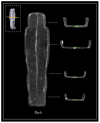X-ray Tomography Unveils the Construction Technique of Un-Montu's Egyptian Coffin (Early 26th Dynasty)
- PMID: 35200741
- PMCID: PMC8879447
- DOI: 10.3390/jimaging8020039
X-ray Tomography Unveils the Construction Technique of Un-Montu's Egyptian Coffin (Early 26th Dynasty)
Abstract
The Bologna Archaeological Museum, in cooperation with prestigious Italian universities, institutions, and independent scholars, recently began a vast investigation programme on a group of Egyptian coffins of Theban provenance dating to the first millennium BC, primarily the 25th-26th Dynasty (c. 746-525 BC). Herein, we present the results of the multidisciplinary investigation carried out on one of these coffins before its restoration intervention: the anthropoid wooden coffin of Un-Montu (Inv. MCABo EG1960). The integration of radiocarbon dating, wood species identification, and CT imaging enabled a deep understanding of the coffin's wooden structure. In particular, we discuss the results of the tomographic investigation performed in situ. The use of a transportable X-ray facility largely reduced the risks associated with the transfer of the large object (1.80 cm tall) out of the museum without compromising image quality. Thanks to the 3D tomographic imaging, the coffin revealed the secrets of its construction technique, from the rational use of wood to the employment of canvas (incamottatura), from the use of dowels to the assembly procedure.
Keywords: X-ray tomography; egyptian coffin; in situ analysis; non-invasive investigations; radiocarbon dating; wood identification.
Conflict of interest statement
The authors declare no conflict of interest.
Figures






















Similar articles
-
Multidisciplinary approach for the study of an Egyptian coffin (late 22nd/early 25th dynasty): combining imaging and spectroscopic techniques.Spectrochim Acta A Mol Biomol Spectrosc. 2015 Jun 15;145:511-522. doi: 10.1016/j.saa.2015.02.052. Epub 2015 Mar 6. Spectrochim Acta A Mol Biomol Spectrosc. 2015. PMID: 25797226
-
Radiological and archaeological investigation of a mummy from Roman Egypt curated in the National Museum of Lithuania.Anthropol Anz. 2016;73(1):69-79. doi: 10.1127/anthranz/2016/0593. Epub 2016 Mar 7. Anthropol Anz. 2016. PMID: 26954562
-
Virtual reconstruction and morphological analysis of the cranium of an ancient Egyptian mummy.Australas Phys Eng Sci Med. 2005 Jun;28(2):122-7. doi: 10.1007/BF03178703. Australas Phys Eng Sci Med. 2005. PMID: 16060319
-
X-ray Imaging Investigation on the Gilding Technique of an Ancient Egyptian Taweret Wooden Statuette.J Imaging. 2021 Oct 29;7(11):229. doi: 10.3390/jimaging7110229. J Imaging. 2021. PMID: 34821860 Free PMC article.
-
From first to latest imaging technology: Revisiting the first mummy investigated with X-ray in 1896 by using dual-source computed tomography.Eur J Radiol Open. 2016 Jul 25;3:172-81. doi: 10.1016/j.ejro.2016.07.002. eCollection 2016. Eur J Radiol Open. 2016. PMID: 27504475 Free PMC article. Review.
Cited by
-
X-ray Digital Radiography and Computed Tomography.J Imaging. 2022 Apr 21;8(5):119. doi: 10.3390/jimaging8050119. J Imaging. 2022. PMID: 35621883 Free PMC article.
References
-
- Cavaleri T., Buscaglia P., Giudice A.L., Nervo M., Pisani M., Re A., Zucco M. Multi and hyperspectral imaging and 3D techniques for understanding egyptian coffins. In: Strudwick H., Dawson J., editors. Ancient Egyptian Coffins: Past, Present, Future. Oxbow Books; Oxford, UK: 2018. pp. 43–51. - DOI
-
- Peccenini E., Albertin F., Bettuzzi M., Brancaccio R., Casali F., Morigi M.P., Petrucci F. Advanced imaging systems for diagnostic investigations applied to cultural heritage. J. Phys. Conf. Ser. 2014;566:012022. doi: 10.1088/1742-6596/566/1/012022. - DOI
-
- Delaney J.K., Zeibel J.G., Thoury M., Littleton R., Palmer M., Morales K.M., de la Rie E.R., Hoenigswald A. Visible and infrared imaging spectroscopy of Picasso’s harlequin musician: Mapping and identification of artist materials in situ. Appl. Spectrosc. 2010;64:584–594. doi: 10.1366/000370210791414443. - DOI - PubMed
-
- Cucci C., Casini A., Picollo M., Stefani L. Optics for Arts, Architecture, and Archaeology IV. Volume 8790. Society of Photo-Optical Instrumentation Engineers (SPIE); Bellingham, WA, USA: 2013. Extending hyperspectral imaging from vis to NIR spectral regions: A novel scanner for the in-depth analysis of polychrome surfaces. - DOI
-
- Ruberto C., Mazzinghi A., Massi M., Castelli L., Czelusniak C., Palla L., Gelli N., Betuzzi M., Impallaria A., Brancaccio R., et al. Imaging study of Raffaello’s “La Muta” by a portable XRF spectrometer. Microchem. J. 2016;126:63–69. doi: 10.1016/j.microc.2015.11.037. - DOI
LinkOut - more resources
Full Text Sources

